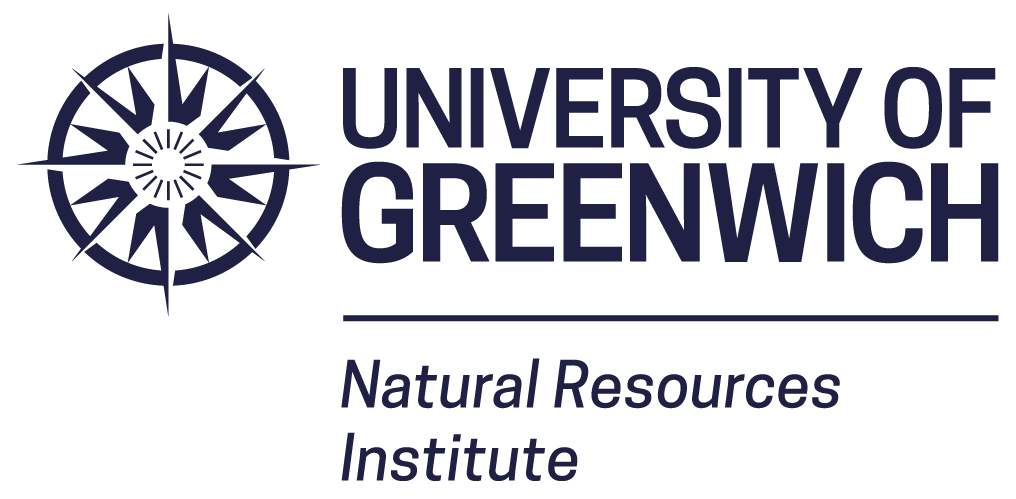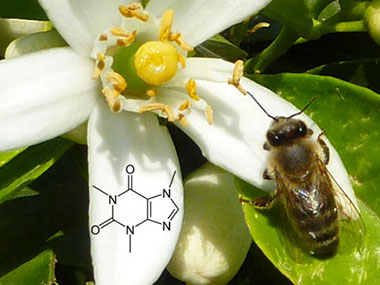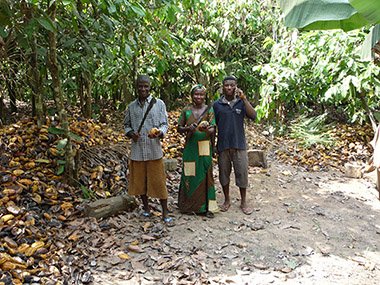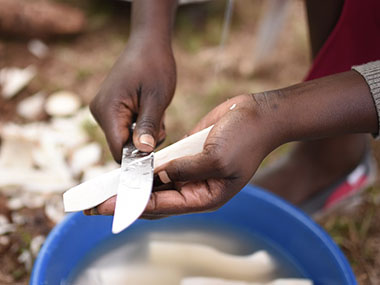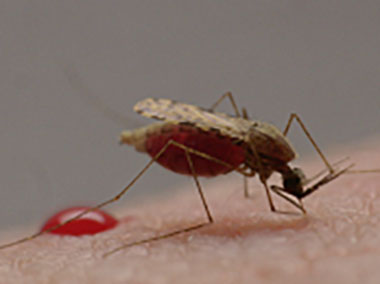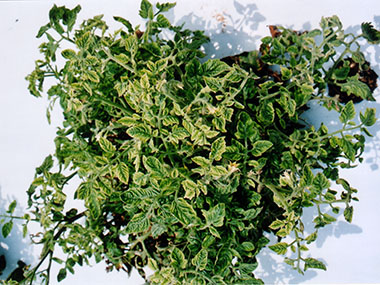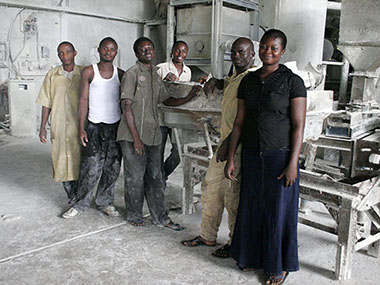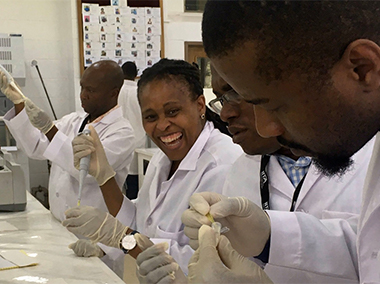Pest Behaviour
The work of the Pest Behaviour Group ranges from laboratory-based research, using cutting-edge technologies, to analyse the basic physiology and behaviour of pests and vectors through field-based studies of pest behaviour and ecology to translational research where knowledge of pest behaviour is used to develop innovative control technologies. This continuum of basic-applied research is applied to insect and mammalian pests impacting on humans, livestock, crops and stored products in the developed and developing world.
Vectors of medical and veterinary importance. We work on the mosquitoes which spread malaria (Anopheles spp.), filariasis (Anopheles and Culex spp.), Zika, dengue (Aedes spp.), the vectors of river blindness (blackfly, Simulium spp.), sleeping sickness (tsetse, Glossina spp.) and species of rat (Rattus, Mastomys) which spread plague, lassa fever and leptospirosis. Research on veterinary pests includes analysis of the behaviour of the species of tsetse which spread African animal trypanosomiasis and biting midges (Culicoides spp.) which transmit blue tongue virus.
Crop Pests. Much of our work on crop pests, conducted in close collaboration with the Chemical Ecology group, is concerned with analysing the behaviour of pests responding to semiochemicals (sex pheromones, attractants, repellents) used to monitor and/or control insects which attack crops directly or spread plant diseases that destroy the crop.
Pests of stored products. The protection of stored grain and pulses with repellent and pesticidal plants is an important part of African farming systems. Our research focusses on analysing how these plants protect stored products with the aim of improving their efficacy and/or developing synthetic protectants that have anti-feedant, repellent or anti-oviposition effects
Our current work includes:
- Laboratory-based studies of the oviposition and host-seeking behaviour of Anopheles gambiae.
- The swarming and mating behaviour of Anopheles mosquitoes.
- Development of natural and artificial baits (insecticide-treated cattle and targets) to lure and kill species of tsetse which spread sleeping sickness.
- Development of Decision Support Systems to guide the effective application of baits to control tsetse.
- Behavioural responses of the cowpea weevil (C. maculatus) to different odours from host and plant-based repellents.
- Development of novel use of repellent plants to protect stored grain from flour beetles (Tribolium spp) and other insects.
Current
Recent
- Linda Brownlow
- Manuela Carnaghi
- Kate Denton
- Christopher Imakando
- Fiona Teltscher
- Jill Joiner
Recent Publications
- Abong’o B, Yu X, Donnelly MJ, Geier M, Gibson G, Gimnig J, ter Kuile F, Lobo NF, Ochomo E, Munga S, Ombok M, Samuels A, Torr SJ, Hawkes FM (2018) Host Decoy Trap (HDT) with cattle odour is highly effective for collection of exophagic malaria vectors. Parasites & Vectors, 11:533https://doi.org/10.1186/s13071-018-3099-7
- Arnold, S.E.J. & Chittka, L. Commentary: Flower colour diversity seen through the eyes of pollinators. Annals of Botany, in press. doi: 10.1093/aob/mcz107
- Bauer, S., Shamoun‐Baranes, J., Nilsson, C., Farnsworth, A., Kelly, J., Reynolds, D.R., Dokter, A.M., Krauel, J., Petterson, L.B., Horton, K.G. & Chapman, J.W. (2018) The grand challenges of migration ecology that radar aeroecology can help answer. Ecography, 42, doi:10.1111/ecog.04083
- Becciu, P., Menz, M.H.M., Aurbach, A., Cabrera-Cruz, S.A., Wainwright, C.E., Scacco, M., Ciach, M., Pettersson, L.B., Maggini, I., Arroyo, G.M., Buler, J.J., Reynolds, D.R. & Sapir, N. (2019) Environmental effects on flying migrants revealed by radar.; Ecography, 42, doi:10.1111/ecog.03995
- Chakma, N., Sarker, N.J., Belmain, S.R., Sarker, S.U., Aplin, K. and Sarker S.K. (2018) New records of rodent species in Bangladesh: Taxonomic studies from rodent outbreak areas in the Chittagong Hill Tracts. Bangladesh J. Zool. 46, 217–230. https://doi.org/10.3329/bjz.v46i2.39055;
- Cheke, R.A. (2018) New pests for old as GMOs bring on substitute pests. Proceedings of the National Academy of Sciences of the USA 115: 8239-8240. Published online 19 July 2018 www.pnas.org/cgi/doi/10.1073/pnas.1811261115.;
- Cheke, R.A. (2018) Foreword. Pages x-xii in Everard, C. Desert Locust Plagues. Controlling the Ancient Scourge. I. B. Tauris, Bloomsbury Press, London & New York. ISBN: 978 1 78831 435 0.
- Cheke, R.A. (2018) European Nightjar new to Togo. Malimbus 40: 75-76.
- Cheke, R.A. & Sidatt, E. H. M. (2019) A review of alternatives to fenthion for quelea bird control. Crop Protection ;116: 15-23. (Published online 10 October 2018) https://doi.org/10.1016/j.cropro.2018.10.005.
- Cheke, R.A., Hawkes, F.M., Gibson, G.I. & Acott, T.G. (2018) Mosquito magnet traps for monitoring host-seeking Simulium. Abstract no 13, page 17 in J. B. Davies (ed.) Proc. 8th. International Simuliidae Symposium, Birmingham, UK, 21-22 June 2018. The Simuliid Bulletin 50 Supplement. (published online 13 August 2018 at https://drive.google.com/drive/folders/0Bz0txvVk5I3Kb3A5X254WVA0bEE).
- Cheke, R.A., Wang, X., Young, S., Tratalos, J.A., Tang, S. & Cressman, K. (2019) What are the ultimate causes of desert locust plagues? Abstract. Proceedings of the 13th Orthopterists’ Congress, 24-28 March 2019, Agadir, Morocco
- Chen, X.-Y., Hopkins, R.J. & Huang, G.H. (2018). Temperature Effects on Development and Fecundity of Microplitis similis (Hymenoptera: Braconidae), a Parasitoid of the Spodoptera litura (Lepidoptera: Noctuidae). (in press Physiological Entomology)
- Cheng, T., Tang, S. & Cheke, R.A. (2019) Threshold dynamics and bifurcation of a state-dependent feedback nonlinear control SIR model. Journal of Computational and Nonlinear Dynamics (in press). Published online 4 March 2019. doi:10.1115/1.4043001
- Debebe, Y.,;Hill, S.,;Tekie, H.,;Ignell, R. &;Hopkins, R. J.;(2018);Shady business: understanding the spatial ecology of exophilic Anopheles mosquitoes.;Malaria Journal (17):351. ISSN 1475-2875 (Online) (doi:10.1186/s12936-018-2499-7)
- He, S., Tang, S., Xiao, Y. & Cheke, R.A. (2018) Stochastic modelling of air pollution impacts on respiratory infection risk. Bulletin of Mathematical Biology 80: 3127–3153. (Published online 2 October 2018). https://doi.org/10.1007/s11538-018-0512-5.
- Hu, G., Lu, M.-H., Reynolds, D.R., Wang, H.-K., Chen, X., Liu, W.-C., Zhu, F., Wu, X.-W., Xia, F., Xie, M.-C., Cheng, X.-N., Lim, K.-S., Zhai, B.-P. & Chapman, J.W. (2018) Long-term seasonal forecasting of a major migrant insect pest: the brown planthopper in the Lower Yangtze River Valley. Journal of Pest Science, 92, 417-428. doi.org/10.1007/s10340-018-1022-9
- Hüppop, O., Ciach, M., Diehl, R., Reynolds, D.R., Stepanian, P.M. & Menz, M.H.M. (2018) Perspectives and challenges for the use of radar in biological conservation. Ecography, 42, doi:10.1111/ecog.04063
- Jones, C.M., Parry, H., Tay, W.T., Reynolds, D.R. & Chapman, J.W. (2019) Movement ecology of pest Helicoverpa: implications for ongoing spread. Annual Review of Entomology, 64, 277-295. doi: 10.1146/annurev-ento-011118-111959
- Land M., Bundschuh M., Hopkins R.J., Poulin B. & McKie B. (2019). What are the effects of control of mosquitoes and other nematoceran Diptera using the microbial agent Bti on aquatic and terrestrial ecosystems? A systematic review protocol. Environmental Evidence (in press)
- Liang, J., Tang, S. & Cheke, R.A. (2018) A discrete host-parasitoid model with evolution of pesticide resistance and IPM strategies. Journal of Biological Dynamics 12: 1059-1078 (published online 24 December 2018) https://doi.org/10.1080/17513758.2018.1556351.
- Mirkovic, D., Stepanian, P.M., Wainwright, C.E., Reynolds, D.R. & Menz, M.H.M. (2018) Characterizing animal anatomy and internal composition for electromagnetic modelling in radar entomology. Remote Sensing in Ecology and Conservation, doi: 10.1002/rse2.94
- Mlyashimbi, E.C.M., Mariën, J., Kimaro, D.N., Tarimo, A.J.P., Isabirye, M., Makundi, R.H., Massawe, A.W., Mdangi, M.E., Kifumba, D., Nakiyemba, A., Leirs, H., Belmain, S.R. and Mulungu, L.S. (2018) Relationships between seasonal changes in diet of multimammate rat (Mastomys natalensis) and its breeding patterns in semi-arid areas in Tanzania. Cogent Food and Agriculture. 4:1507509. https://doi.org/10.1080/23311932.2018.1507509
- Moeini, P. Afsharifar, A, Homayoonzadeh, M, & Hopkins R.J. (2019). Plant virus infection modifies plant pigment and manipulates the host preference behavior of an insect vector; Arthropod Plant Interactions (in press)
- Ojija, F., Arnold, S.E.J. & Treydte, A.C. Impacts of alien invasive Parthenium hysterophorus on flower visitation by insects to co-flowering plants. Arthropod-Plant Interactions, doi: 10.1007/s11829-019-09701-3
- Scott-Brown, A.S., Arnold, S.E.J., Kite, G., Farrell, I.W., Farman, D.I., Collins, D.W. & Stevenson, P.C. Mechanisms in mutualisms: A chemically mediated thrips pollination strategy in common elder. Planta. doi: 10.1007/s00425-019-03176-5
- Sikorska, D., Garnis, J., Dąbrowski, Z.T., Sikorski, P., Gozdowski, D., d & Hopkins, R.J. (2019) Thus far but no further: Predatory mites do not migrate effectively into strawberry plantations. Experimental and Applied Acarology 77(3), 359-373, 2019 https://doi.org/10.1007/s10493-019-00357-5
- Stevenson, P. C., Green, P. W. C., Farrell, I. W., Brankin, A., Mvumi, B. M., & Belmain, S. R. (2018). Novel Agmatine Derivatives in Maerua edulis With Bioactivity Against Callosobruchus maculatus, a Cosmopolitan Storage Insect Pest. Frontiers in Plant Science, 9, https://doi.org/10.3389/fpls.2018.01506
- Tan, Y., Ning, J., Tang, S. & Cheke, R.A. (2019) Optimal threshold density;in a stochastic resource management model with pulse intervention. ;Natural Resource Modeling ;(in press). Published online 17 May 2019. https://doi.org/10.1111/nrm.12220
- Tang, S., Liang, J., Xiang, C., Xiao, Y., Wang, X., Wu, J., Li, G.; & Cheke, R.A. (2019). A general model of hormesis and its application to pest management. Journal of the Royal Society Interface (in press)
- Tembo, Y., Mkindi, A. G., Mkenda, P. A., Mpumi, N., Mwanauta, R., Stevenson, P. C., Ndakidemi, P.A. and Belmain, S. R. (2018). Pesticidal Plant Extracts Improve Yield and Reduce Insect Pests on Legume Crops Without Harming Beneficial Arthropods. Frontiers in Plant Science, 9, 1425. https://doi.org/10.3389/fpls.2018.01425
- Tian, Y., Tang, S. & Cheke, R.A. (2018) Nonlinear state-dependent feedback control of a pest-natural enemy system. Nonlinear Dynamics 94: 2243–2263. (https://doi.org/10.1007/s11071-018-4487-4 ;(published online 31 July 2018).
- Tian, Y., Tang, S. & Cheke, R.A. (2019) Dynamic complexity of a predator-prey model for IPM with nonlinear impulsive control incorporating a regulatory factor for predator releases. Mathematical Modelling and Analysis 24: 134-154 (published online 5 January 2019). DOI: https:/doi.org/10.3846/mma.2019.010
- Veriegh, F.B.D., Basáñez, M.-G., Baidoo, P.K., Agyeman, A., Badu, K., Armoo, S., Wilson, M.D., Boakye, D.A., Cheke, R.A., Taylor, M. & Osei-Atweneboana, M.Y. (2018) Geo-statistical analysis of continual onchocerciasis transmission in and around areas receiving bi-annual ivermectin treatment regimens. Session 22 Poster abstract 114. Proceedings of the Annual Meeting of the American Society of Tropical Medicine and Hygiene, 28 October - 1 November;2018, New Orleans, Louisiana, U.S.A. Available online at https://www.abstractsonline.com/pp8/#!/4692/presentation/14431.
- Wang, X., Tang, S., Wu, J., Xiao, Y. & Cheke, R. A. (2019) A combination of climatic conditions determines major within-season dengue outbreaks in Guangdong Province, China. Parasites & Vectors 12: 45. Published online 21 January 2019. https://doi.org/10.1186/s13071-019-3295-0
- Wang, J., Xiao, Y. & Cheke, R.A. (2019) Modelling the effects of contaminated environments in mainland China on seasonal HFMD infections and the potential benefit of a pulse vaccination strategy. Discrete and Continuous Dynamical Systems Series B. doi:;10.3934/dcdsb.2019109
- Williams, S.T., Maree, N., Taylor, P., Belmain, S.R., Keith, M. and Swanepoel, L.H. (2018). Camera trap and questionnaire dataset on ecosystem services provided by small carnivores in agro-ecosystems in South Africa. Data in Brief. 18:753-759. https://doi.org/10.1016/j.dib.2018.03.071
- Yang, J., Tan, Y. & Cheke, R.A. (2019) Thresholds for extinction and proliferation in a stochastic tumour-immune model with pulsed comprehensive therapy. Communications in Nonlinear Science and Numerical Simulation 73: 363-378. Published online 1 March 2019. doi: https://doi.org/10.1016/j.cnsns.2019.02.025
- Yang, J., Tan, Y. & Cheke, R.A. (2019) Modelling effects of a chemotherapeutic dose response on a stochastic tumour-immune model. Chaos, Solitons and Fractals (in press)
